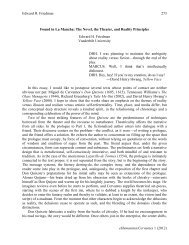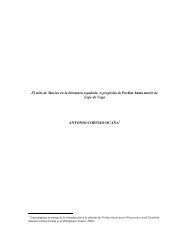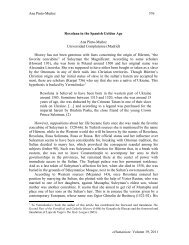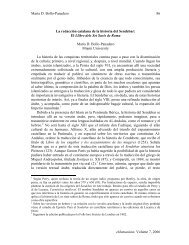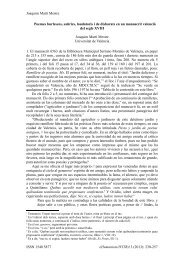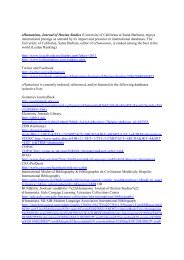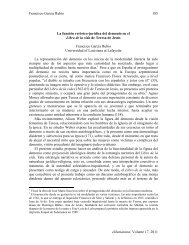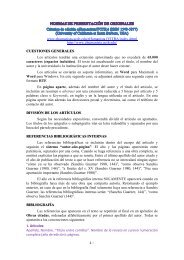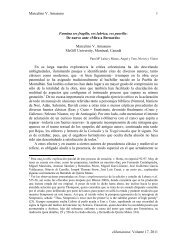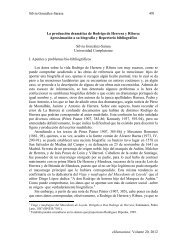Gregory Peter Andrachuk eHumanista: Volume 17, 2011 540 Alonso ...
Gregory Peter Andrachuk eHumanista: Volume 17, 2011 540 Alonso ...
Gregory Peter Andrachuk eHumanista: Volume 17, 2011 540 Alonso ...
Create successful ePaper yourself
Turn your PDF publications into a flip-book with our unique Google optimized e-Paper software.
<strong>Gregory</strong> <strong>Peter</strong> <strong>Andrachuk</strong><br />
these and other holdings Pastor Zapata remarks: “este conjunto territorial convertirá a<br />
la rama valenciana de los Cardona en una de las más influyentes familias del área del<br />
sur de Valencia durante los siglos XV y XVI” (743). 31 The sale of the Real de Gandía<br />
is a key element in determining the lineage and identity of <strong>Alonso</strong> de Cardona. Pastor<br />
Zapata, remarking on the continued economic problems faced by the owners of this<br />
property, comments: “el problema de las deudas censales en la baronía del Real se<br />
perfiló en todas sus implicaciones en la primera mitad del siglo XV…Don Juan y Don<br />
<strong>Alonso</strong>, herederos de Hugo de Cardona, contemplaron y contribuyeron, con sus<br />
abusivas peticiones, al continuo deterioro de su solvencia económica” (745). It is the<br />
enormous debts which cause them to sell the property to María Enríquez de Borja.<br />
Pastor Zapata remarks on having a “documento especialmente valioso” (751) for his<br />
study of the Real de Gandía –but this document is also of particular interest to us here<br />
because it records the sale of the property (signed February 1, 1502) “entre los<br />
vendedores, don Juan de Cardona y doña María Fajardo y el hijo de ambos Don<br />
<strong>Alonso</strong>, y la compradora, la duquesa de Gandía, doña María Enríquez de Borja” (751,<br />
emphasis mine). As Pastor Zapata documents, this was neither the first nor the last<br />
connection between the Cardonas and the Borjas.<br />
For the sake of clarity, it is this <strong>Alonso</strong>, descended from Hugo Folch de Cardona,<br />
eleventh Barón de Bellpuig, 32 who later became lord of Guadalest and Almirante de<br />
Aragón. 33 As a descendant of Hugo, <strong>Alonso</strong> is related directly to Ramón Folch de<br />
Cardona, Viceroy of Naples. Hugo had two sons: Ramón, married to Catalina de<br />
31 The fact that Ondara was held by Juan Folch de Cardona, lord of Guadalest, and that there was a long<br />
history of dispute between Juan Folch de Cardona and the Duque de Gandía and later, his widow María<br />
throws doubt on Perea Rodríguez’s assertions regarding the relationship between the Cancionero<br />
General poets Juan and <strong>Alonso</strong> de Cardona; see n.<strong>17</strong> infra. I believe that he may have confused Juan,<br />
the father of <strong>Alonso</strong> Folch de Cardona and Juan, the poet who may or may not have been the Conde de<br />
Avellino but almost certainly was not the brother of <strong>Alonso</strong>.<br />
32 The hereditary title of Almirante, given first in 1364 to Hugo Folch de Cardona, was inherited by<br />
Hugo’s grandson <strong>Alonso</strong> and passed to his heirs. The mother of <strong>Alonso</strong> de Cardona, Almirante and lord<br />
of Guadalest, is acknowledged by almost every source as being María de Fajardo, sister of Don Pedro<br />
Fajardo, Adelantado Mayor del Reino de Murcia, but Grandes de España, based on Jacobo Wilhelm<br />
Imhof (Genealogiae viginti illustrium in Hispania familiarum, Norimburgo, <strong>17</strong>12) in one listing gives<br />
the mother of “Alfonso (sic) de Cardona, señor de Guadalest, Almirante de Aragón” as Juana de Gandía<br />
–possibly a confusion with María Enríquez de Borja, Duquesa de Gandía (http://grandesp.org.uk/<br />
historia/gzas/cardonacde.htm). Yet in another listing it does give the mother of Al(f)onso, “barón de<br />
Guadalest, Almirante de Aragón” as María de Fajardo (http://grandesp.org.uk/historia/gzas/<br />
cardonadq.htm). Several sources, give Ramón Folch de Cardona, sixteenth Barón de Bellpuig, Viceroy<br />
of Naples, son of Antonio Folch de Cardona and Castellana de Requeséns, as descendant of Hugo. It is<br />
worthy of note that the arms of the Cardona lords of Guadalest include those of the Cardona lords of<br />
Bellpuig: the normal three golden thistles on a red field, described as “en campo de gules tres cardos de<br />
oro puestos en triángulo” (www.Famorca.es). These same thistles on a field of red are used by Marqués<br />
de la Pádula (Grandes de España).<br />
33 The identification of the lord of Guadalest as Almirante de Aragón is supported by numerous other<br />
sources including Ángel González Palencia: “El Almirante de Aragón era don <strong>Alonso</strong> Folch de Cardona<br />
y Fajardo” (125).<br />
554<br />
<strong>eHumanista</strong>: <strong>Volume</strong> <strong>17</strong>, <strong>2011</strong>



